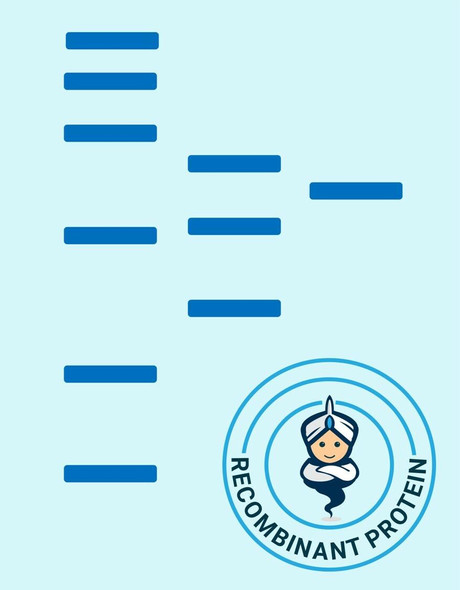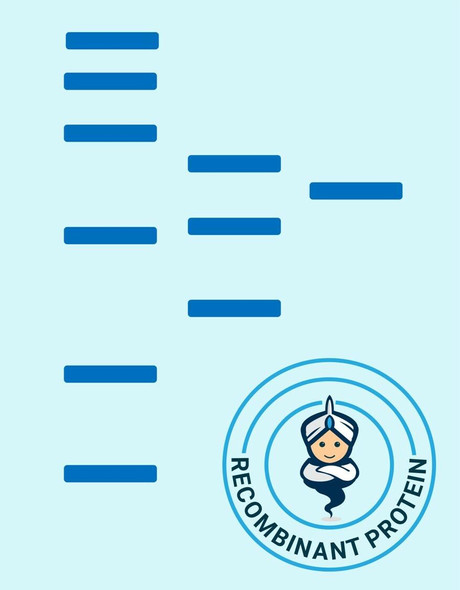Description
| Product Name: | Human ASPH Recombinant Protein |
| Product Code: | RPPB1423 |
| Size: | 20µg |
| Species: | Human |
| Target: | ASPH |
| Synonyms: | AAH, BAH, CASQ2BP1, HAAH, JCTN, Junctin, EC 1.14.11.16, Aspartyl/asparaginyl beta-hydroxylase, Aspartate beta-hydroxylase, Peptide-aspartate beta-dioxygenase, ASP beta-hydroxylase, ASPH. |
| Source: | Escherichia Coli |
| Physical Appearance: | Sterile Filtered colorless solution. |
| Formulation: | The ASPH protein solution contains 20mM Tris-HCl pH-8, 1mM DTT and 10% glycerol. |
| Stability: | Store at 4°C if entire vial will be used within 2-4 weeks. Store, frozen at -20°C for longer periods of time. For long term storage it is recommended to add a carrier protein (0.1% HSA or BSA).Avoid multiple freeze-thaw cycles. |
| Purity: | Greater than 90.0% as determined by SDS-PAGE. |
| Amino Acid Sequence: | MGSSHHHHHH SSGLVPRGSH MFDLVDYEEV LGKLGIYDAD GDGDFDVDDA KVLLGLKERS TSEPAVPPEE AEPHTEPEEQ VPVEAEPQNI EDEAKEQIQS LLHEMVHAEH ETEHSYHVEE TVSQDCNQDM EEMMSEQENP DSSEPVVEDE RLHHDTDDVT YQVYEEQAVY EPLENEGIEI TEVTAPPEDN PVEDSQVIVE EVSIFPVEEQ QEVPPDT |
ASPH hydroxylates an Asp or Asn residue in EGF domains. ASPH is involved in calcium homeostasis. ASPH is expressed from two promoters and goes through extensive alternative splicing. The encoded set of ASPH proteins share varying quantities of overlap near their N-termini although have considerable differences in their C-terminal domains resulting in distinct functional properties. The longest isoforms (a and f) include a C-terminal Aspartyl/Asparaginyl beta-hydroxylase domain that hydroxylates aspartic acid or asparagine residues in the EGF domain, including protein C, coagulation factors VII, IX, and X, and the complement factors C1R and C1S. Further isoforms diverge mainly in the C-terminal sequence and lack the hydroxylase domain, and some have been localized to the endoplasmic and sarcoplasmic reticulum.
ASPH Human Recombinant produced in E.Coli is a single, non-glycosylated polypeptide chain containing 217 amino acids (75-270 a.a.) and having a molecular mass of 24.5 kDa. The ASPH is fused to a 20 amino acid His Tag and purified by conventional chromatography.
| UniProt Protein Function: | ASPH: Isoform 1: specifically hydroxylates an Asp or Asn residue in certain epidermal growth factor-like (EGF) domains of a number of proteins. Belongs to the aspartyl/asparaginyl beta-hydroxylase family. 9 isoforms of the human protein are produced by alternative splicing. |
| UniProt Protein Details: | Protein type:Membrane protein, integral; Oxidoreductase; EC 1.14.11.16 Chromosomal Location of Human Ortholog: 8q12.1 Cellular Component: endoplasmic reticulum membrane; sarcoplasmic reticulum membrane; sarcoplasmic reticulum lumen; endoplasmic reticulum; integral to membrane; plasma membrane; integral to endoplasmic reticulum membrane Molecular Function:protein binding; electron carrier activity; structural constituent of muscle; calcium ion binding; structural molecule activity; peptide-aspartate beta-dioxygenase activity Biological Process: negative regulation of cell proliferation; peptidyl-aspartic acid hydroxylation; activation of store-operated calcium channel activity; muscle contraction; positive regulation of proteolysis; positive regulation of transcription, DNA-dependent; regulation of protein stability; regulation of inositol-1,4,5-triphosphate receptor activity; palate development; detection of calcium ion; limb morphogenesis; pattern specification process; response to ATP |
| NCBI Summary: | This gene is thought to play an important role in calcium homeostasis. The gene is expressed from two promoters and undergoes extensive alternative splicing. The encoded set of proteins share varying amounts of overlap near their N-termini but have substantial variations in their C-terminal domains resulting in distinct functional properties. The longest isoforms (a and f) include a C-terminal Aspartyl/Asparaginyl beta-hydroxylase domain that hydroxylates aspartic acid or asparagine residues in the epidermal growth factor (EGF)-like domains of some proteins, including protein C, coagulation factors VII, IX, and X, and the complement factors C1R and C1S. Other isoforms differ primarily in the C-terminal sequence and lack the hydroxylase domain, and some have been localized to the endoplasmic and sarcoplasmic reticulum. Some of these isoforms are found in complexes with calsequestrin, triadin, and the ryanodine receptor, and have been shown to regulate calcium release from the sarcoplasmic reticulum. Some isoforms have been implicated in metastasis. [provided by RefSeq, Sep 2009] |
| UniProt Code: | Q12797 |
| NCBI GenInfo Identifier: | 145559444 |
| NCBI Gene ID: | 444 |
| NCBI Accession: | Q12797.3 |
| UniProt Secondary Accession: | Q12797,Q6NXR7, Q8TB28, Q9H291, Q9H2C4, A6NDF4, A6NHI2 B4DIC9, B4E2K4, B7ZM95, E5RGP5, F5H667, |
| UniProt Related Accession: | Q12797 |
| Molecular Weight: | 758 |
| NCBI Full Name: | Aspartyl/asparaginyl beta-hydroxylase |
| NCBI Synonym Full Names: | aspartate beta-hydroxylase |
| NCBI Official Symbol: | ASPH�� |
| NCBI Official Synonym Symbols: | AAH; BAH; HAAH; JCTN; FDLAB; junctin; CASQ2BP1�� |
| NCBI Protein Information: | aspartyl/asparaginyl beta-hydroxylase; humbug; junctate; A beta H-J-J; cardiac junctin; ASP beta-hydroxylase; peptide-aspartate beta-dioxygenase; aspartyl/asparaginyl-beta-hydroxylase |
| UniProt Protein Name: | Aspartyl/asparaginyl beta-hydroxylase |
| UniProt Synonym Protein Names: | Aspartate beta-hydroxylase; ASP beta-hydroxylase; Peptide-aspartate beta-dioxygenase |
| Protein Family: | Aspartyl/asparaginyl beta-hydroxylase |
| UniProt Gene Name: | ASPH�� |
| UniProt Entry Name: | ASPH_HUMAN |








